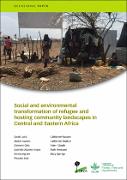| dc.contributor.author | Laird, Sarah | |
| dc.contributor.author | Awono, Abdon | |
| dc.contributor.author | Okia, Clement Akais | |
| dc.contributor.author | Anaya, Gabriela Alvarez | |
| dc.contributor.author | Ingram, Verina | |
| dc.contributor.author | Sola, Phosiso | |
| dc.contributor.author | Watson, Catharine | |
| dc.contributor.author | Muthuri, Catherine | |
| dc.contributor.author | Gilruth, Peter | |
| dc.contributor.author | Mendum, Ruth | |
| dc.contributor.author | Njenga, Mary | |
| dc.date.accessioned | 2023-02-12T21:06:14Z | |
| dc.date.available | 2023-02-12T21:06:14Z | |
| dc.date.issued | 2022 | |
| dc.identifier.citation | Laird, S., Awono, A., Okia, C. A, Alvarez Anaya, G., Ingram, V., Sola, P., ... & Njenga, M. (2022). Social and environmental transformation of refugee and hosting community landscapes in Central and Eastern Africa (Vol. 229). CIFOR. | en_US |
| dc.identifier.uri | http://dir.muni.ac.ug/xmlui/handle/20.500.12260/491 | |
| dc.description.abstract | Sub-Saharan Africa hosts more than 26% of the world’s refugee population, with 6.3 million refugees – which represents a 186% increase in the last decade, from 2.2 million. There has been an increase in internally displaced persons (IDPs) following conflicts and violence in South
Sudan, the Democratic Republic of Congo (DRC), the Central African Republic (CAR), and the Lake Chad basin. The population of refugee settlements disproportionately comprises women and children, and is characterized by highly diverse cultural backgrounds, with some settlements having people from approximately 10 nationalities. In many areas, refugees and IDPs add pressure to already vulnerable ecosystems and existing social tensions, leading to land use and resource conflicts among displaced people and host communities. Overharvesting of natural resources, competition over resources, and entering host communities’ common or private lands without consent are the main drivers of conflict between host communities and refugees. These conflict situations are aggravated by the impact of climate change, deforestation, and environmental degradation, which are recognized by humanitarian organizations and are placed at the centre of their agendas. This document synthesises the challenges in environmental sustainability facing refugee-hosting landscapes, on-going initiatives, and gaps. It also presents transformative science plans by CIFORICRAF to address exiting gaps towards resilient landscapes and livelihoods. CIFOR-ICRAF is a research institution in forestry and landscape management, which has evolved out of an effective merger between CIFOR and ICRAF. Resilience, sustainability, and environmental health in host landscapes are multi-faceted and complex, with cultural, ecological, economic, social, and political dimensions. Therefore, despite various organisations working in refugee-hosting landscapes, there are still challenges in achieving holistic, long-term and sustainable solutions [...] | en_US |
| dc.language.iso | en | en_US |
| dc.publisher | Center for International Forestry Research | en_US |
| dc.relation.ispartofseries | ;229 | |
| dc.subject | Social and environmental transformation | en_US |
| dc.subject | Social transformation | en_US |
| dc.subject | Environmental transformation | en_US |
| dc.subject | Refugee | en_US |
| dc.subject | Refugee and hosting community | en_US |
| dc.subject | Landscapes | en_US |
| dc.subject | Central and Eastern Africa | en_US |
| dc.title | Social and environmental transformation of refugee and hosting community landscapes in Central and Eastern Africa. | en_US |
| dc.type | Other | en_US |

